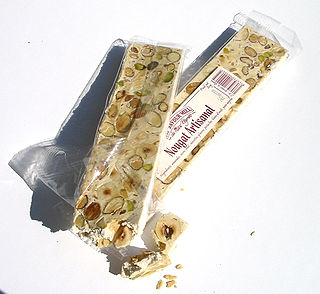A miniature is a small-scale reproduction, or a small version. It may refer to:

Nougat is a family of confections made with sugar or honey, roasted nuts, whipped egg whites, and sometimes chopped candied fruit. The consistency of nougat is chewy, and it is used in a variety of candy bars and chocolates. The word nougat comes from Occitan pan nogat, seemingly from Latin panis nucatus 'nut bread'.

The froghoppers, or the superfamily Cercopoidea, are a group of hemipteran insects in the suborder Auchenorrhyncha. Adults are capable of jumping many times their height and length, giving the group their common name, but they are best known for their plant-sucking nymphs which encase themselves in foam in springtime.

Candy-O is the second studio album by the American rock band the Cars. It was released in 1979 on Elektra Records. Featuring the Top 20 hit "Let's Go" and the minor hit "It's All I Can Do", the album charted 15 places higher than its predecessor on the Billboard Hot 100. The album features cover art by pin-up artist Alberto Vargas.

Caramel apples or taffy apples are created by dipping or rolling apples-on-a-stick in hot caramel, sometimes then rolling them in nuts or other small savories or confections, and allowing them to cool. Generally, they are called caramel apples when only caramel is applied and taffy apples for when there are further ingredients such as peanuts applied.

Brachypodium pinnatum, the heath false brome or tor-grass, is a species of grass with a widespread distribution in temperate regions of the Northern Hemisphere. It typically grows in calcareous grassland, and reaches 70–120 centimetres (28–47 in) tall. The flowerhead is open, with 10 to 15 erect spikelets.

A leafhopper is the common name for any species from the family Cicadellidae. These minute insects, colloquially known as hoppers, are plant feeders that suck plant sap from grass, shrubs, or trees. Their hind legs are modified for jumping, and are covered with hairs that facilitate the spreading of a secretion over their bodies that acts as a water repellent and carrier of pheromones. They undergo a partial metamorphosis, and have various host associations, varying from very generalized to very specific. Some species have a cosmopolitan distribution, or occur throughout the temperate and tropical regions. Some are pests or vectors of plant viruses and phytoplasmas. The family is distributed all over the world, and constitutes the second-largest hemipteran family, with at least 20,000 described species.

The Auchenorrhyncha suborder of the Hemiptera contains most of the familiar members of what was called the Homoptera – groups such as cicadas, leafhoppers, treehoppers, planthoppers, and spittlebugs. The aphids and scale insects are the other well-known "Homoptera", and they are in the suborder Sternorrhyncha. Lesser-known insects largely regarded as Homoptera are the Coleorrhyncha. However, the taxonomic status of the Hemiptera and Homoptera is currently under investigation and discussion. See Heteroptera and Prosorrhyncha for more information.

The octave mandolin is a fretted string instrument with four pairs of strings tuned in fifths, G, D, A, E, an octave below a mandolin. It is larger than the mandola, but smaller than the mandocello and its construction is similar to other instruments in the mandolin family. Usually the courses are all unison pairs but the lower two may sometimes be strung as octave pairs with the higher-pitched octave string on top so that it is hit before the thicker lower-pitched string. Alternate tunings of G, D, A, D and A, D, A, D are often employed by Celtic musicians.

The superfamily Membracoidea are sap-sucking true-bugs that includes two of the largest families within what used to be called the "Homoptera"; the leafhoppers (Cicadellidae) and the treehoppers (Membracidae). The other families in this group are quite small, and have, at various points, generally been included as members within other families, though they are all presently considered to be valid, monophyletic groups. The odd, relictual family Myerslopiidae is one of the most recently described of all Hemipteran families.

The mandore is a musical instrument, a small member of the lute family, teardrop shaped, with four to six courses of gut strings and pitched in the treble range. Considered a French instrument, with many of the surviving music coming from France, it was used across "Northern Europe" including Germany and Scotland. Although it went out of style, the French instrument has been revived for use in classical music. The instrument's most commonly played relatives today are members of the mandolin family and the bandurria.

Graphocephala coccinea is a meadow and woodland-dwelling species of brightly colored leafhopper native to North and Central America, from Canada south to Panama. Common names include candy-striped leafhopper, red-banded leafhopper, scarlet-and-green leafhopper and red-and-blue leafhopper.

Graphocephala is a large genus of leafhoppers, found from southern Canada to northern South America.

A Horse Called Music is the thirty-seventh studio album by country singer Willie Nelson. The album includes Nelson's last number 1 single, "Nothing I Can Do About It Now", and the single "There You Are", which peaked at #8 on the Billboard country chart.

Mandolin Abstractions is an album by American musicians David Grisman and Andy Statman, released in 1983.

Matru Ki Bijlee Ka Mandola is a 2013 Indian black comedy film produced by Vishal Bhardwaj along with Fox Star Studios. Besides co-producing, Bhardwaj has also directed, co-scripted and scored the music for the film. The film stars Pankaj Kapur, Imran Khan and Anushka Sharma in the titular roles, while Shabana Azmi and Arya Babbar play supporting roles. The film was released worldwide on 11 January 2013.

The Phosphorescent Blues is the fourth studio album by the American group Punch Brothers, released on January 27, 2015. The band announced the release of the album's first single, "I Blew It Off", on November 17, 2014, On December 4, 2014, the group announced the album's name and release date, along with the second single, "Julep". Julep was nominated for Best American Roots Song at the 2016 Grammy Awards. The album's cover is from the René Magritte painting "The Lovers" (1928).















